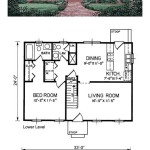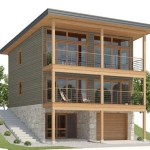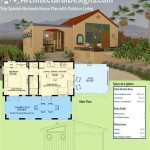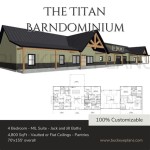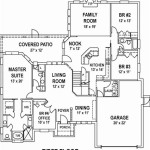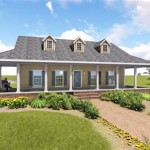Understanding Two-Bedroom Floor Plans With Dimensions
A two-bedroom floor plan is a common and versatile housing option suitable for diverse occupants, including small families, couples, roommates, or individuals seeking extra space for a home office or hobbies. The appeal of these layouts lies in their balance of affordability and functionality. This article provides a comprehensive overview of two-bedroom floor plans, with a particular emphasis on understanding the significance of dimensions and how they impact the overall livability of the space.
When analyzing a two-bedroom floor plan, dimensions are not merely quantitative values; they represent the actual usable space within each room and the relationships between those spaces. Understanding these dimensions is crucial for making informed decisions about furniture placement, traffic flow, and overall suitability for one’s needs. A seemingly minor difference in dimensions can drastically affect the functionality and comfort of a room. Therefore, a meticulous review of the provided measurements is essential before committing to a particular layout.
Many factors determine the ideal two-bedroom floor plan, including lifestyle, personal preferences, and budget. This guide aims to empower individuals with the knowledge necessary to effectively interpret floor plans and make informed choices based on their unique requirements. We will explore the key areas within a two-bedroom apartment or house, examining typical dimensions and considering how these measurements contribute to the overall living experience.
Key Point 1: Deciphering Floor Plan Dimensions
Floor plans are scaled diagrams that depict the layout of a building or apartment. They provide a bird's-eye view of the space, showcasing the arrangement of rooms, walls, doors, windows, and built-in fixtures. The inclusion of dimensions is what differentiates a basic floor plan from a truly informative one. These dimensions, typically expressed in feet and inches (or meters and centimeters), allow prospective buyers or renters to visualize the actual size of each room and the relationship between them.
Commonly, dimensions are indicated inside the room boundaries or along the exterior walls. They usually represent the length and width of the room. For example, a dimension labeled “12’ x 14’” indicates a room that is 12 feet wide and 14 feet long. It is crucial to understand the units used in the floor plan, as misinterpreting them can lead to significant errors in spatial planning. Smaller dimensions are often included for hallways, closets, bathrooms, and other ancillary spaces.
Furthermore, it’s imperative to note whether the dimensions provided are interior or exterior measurements. Interior dimensions represent the actual usable space within the walls, while exterior dimensions include the thickness of the walls themselves. For practical purposes, interior dimensions are almost always the more relevant figure when assessing the size and functionality of a room. Additionally, pay close attention to any notations regarding ceiling height, as this can significantly impact the feeling of spaciousness within the unit.
When reviewing dimensions, consider the shape of the room. While rectangular or square rooms are straightforward to assess, irregularly shaped rooms can be more challenging. In these cases, the floor plan might provide multiple dimensions to represent the varying lengths and widths. It may also be helpful to sketch out the room on paper and calculate the square footage to get a better understanding of the overall space.
Understanding the scale of the floor plan is also critical. The scale, usually indicated in a corner of the drawing (e.g., 1/4" = 1'), indicates the relationship between the dimensions on the plan and the actual dimensions of the building. This allows you to measure distances on the plan and convert them to real-world measurements. If the scale is not clearly indicated, it is wise to confirm it with the architect or property manager.
Key Point 2: Typical Dimensions for Key Areas in a Two-Bedroom Floor Plan
While the specific dimensions of a two-bedroom floor plan can vary considerably depending on the overall design, size of the building, and location, there are some typical ranges that can serve as useful benchmarks. Understanding these typical dimensions can help you assess whether a particular floor plan meets your needs and expectations.
Master Bedroom: The master bedroom is typically the largest bedroom in the unit. A comfortable master bedroom should ideally be at least 12’ x 12’ (144 square feet). However, many master bedrooms range from 12’ x 14’ to 14’ x 16’ or even larger. This allows for the placement of a queen or king-size bed, bedside tables, and a dresser. Ample space for walking around the bed and accessing closets is also important. A walk-in closet can significantly increase the functionality and desirability of the master bedroom.
Second Bedroom: The second bedroom is often smaller than the master bedroom. A standard size for a second bedroom is around 10’ x 10’ (100 square feet) or 10’ x 12’ (120 square feet). This size is often suitable for a single bed, a dresser, and a small desk, making it ideal for a child's room, a guest room, or a home office. Larger second bedrooms, around 12’ x 12’, can comfortably accommodate a double bed or even a queen-size bed. Closet space is equally vital in the second bedroom for storage and organization.
Living Room: The living room is typically the central hub of the unit, intended for relaxation and entertainment. A comfortable living room should be at least 14’ x 16’ (224 square feet). Larger living rooms, exceeding 16’ x 20’ or more, offer more flexibility in terms of furniture arrangement and seating capacity. Consider the placement of furniture such as sofas, armchairs, coffee tables, and entertainment centers when evaluating the size of the living room. The location of windows and doors will also impact the layout possibilities.
Kitchen: The kitchen's dimensions depend heavily on the layout and the presence of an island or peninsula. A compact kitchen might be around 8’ x 10’ (80 square feet), while a larger, eat-in kitchen could be 10’ x 14’ (140 square feet) or more. The amount of counter space available, the placement of appliances (refrigerator, stove, dishwasher), and the presence of storage cabinets are critical factors to consider. Sufficient space for food preparation and movement within the kitchen is essential.
Bathrooms: The size of bathrooms in a two-bedroom unit can vary. A standard full bathroom (with a toilet, sink, and shower/tub combination) might be around 5’ x 8’ (40 square feet). Larger bathrooms, particularly those attached to the master bedroom, may feature separate showers and tubs, as well as double sinks, requiring dimensions of 8’ x 10’ or more. A half bathroom (with a toilet and sink) is typically smaller, around 3’ x 6’.
Hallways: Hallways connect different areas of the unit and should be wide enough to allow for comfortable passage. A minimum width of 3 feet (36 inches) is generally recommended for hallways. Narrow hallways can feel cramped and make it difficult to move furniture. Consider the length of hallways when assessing the overall flow of the floor plan.
Closets: Closet dimensions are often overlooked but can significantly impact storage capacity. A standard reach-in closet might be 2’ deep and 4’ to 6’ wide. Walk-in closets provide significantly more storage space and can range in size from 4’ x 6’ to 6’ x 8’ or larger. Closet organization systems can further maximize the use of available space.
Key Point 3: Analyzing Dimensions for Functionality and Flow
Beyond simply noting the dimensions of each room, it is crucial to analyze how these dimensions contribute to the overall functionality and flow of the two-bedroom floor plan. This involves considering how the rooms relate to one another, how traffic will flow through the space, and how well the layout accommodates your specific lifestyle needs.
Traffic Flow: Observe the layout to determine how people will move through the unit. Are there any bottlenecks or areas where traffic is likely to be congested? Ideally, the flow should be smooth and intuitive, allowing for easy access to all rooms without having to navigate through overly narrow hallways or awkward corners. The placement of doors and windows can significantly impact traffic flow, so pay close attention to their location on the floor plan.
Furniture Placement: Visualize how you would arrange your furniture in each room based on the dimensions provided. Consider the size and shape of your existing furniture and how it will fit into the available space. Will there be enough room to comfortably move around the furniture? Are there enough electrical outlets in convenient locations? If you are unsure, consider using furniture planning software or sketching out possible layouts on paper.
Relationship between Rooms: Evaluate how the different rooms relate to one another. For example, is the kitchen conveniently located near the dining area? Is the master bedroom separated from the living room to provide privacy and noise reduction? Consider how the arrangement of rooms will impact your daily routine and activities. An open-concept layout, where the living room, dining area, and kitchen are combined into one large space, can be ideal for entertaining but may offer less privacy.
Natural Light and Ventilation: The location and size of windows are crucial for natural light and ventilation. Larger windows and strategically placed windows can brighten up the space and improve air circulation. Consider the orientation of the unit and how sunlight will enter the rooms at different times of the day. A floor plan with limited natural light can feel dark and cramped, even if the dimensions are adequate.
Storage Space: Adequate storage space is essential for maintaining a clutter-free and organized living environment. Review the floor plan to assess the amount of closet space, cabinet space, and other storage areas available. Consider whether there is enough storage for your belongings, taking into account your lifestyle and needs. If storage is limited, you may need to invest in additional storage solutions, such as shelving units or storage bins.
Accessibility: If you or a member of your household has mobility issues, it is important to consider accessibility features such as wider doorways, ramps, and roll-in showers. Review the floor plan to ensure that the layout is accessible and that there are no obstacles that would make it difficult to move around the unit. Minimum doorway width should be 32 inches to accommodate wheelchair access.
In conclusion, understanding the dimensions provided in a two-bedroom floor plan is essential for making informed decisions about housing. By carefully analyzing the dimensions of each room, considering the traffic flow and furniture placement, and evaluating the relationship between rooms, individuals can determine whether a particular floor plan meets their specific needs and preferences. This detailed analysis will ultimately contribute to a more comfortable and functional living experience.

2 Bedroom Modular Home Floor Plans Rba Homes Bungalow Condo

Pin On Small House Plans

A Two Dimensional Drawing Showing The Ground Floor Plan Of Bedroom Scientific Diagram

Simple Two Bedroom House Plans With Dimension Cadbull

Two Bedroom Small House Plan Cool Concepts Design Plans

Practical 2 Bedroom House Plan With L Shaped Kitchen

Two Bedroom Small House Design Shd 2024030 Pinoy Eplans

Modern Tiny House Plan 2 Bedroom Amp 1 Bathroom With Free Cad File

12 Simple 2 Bedroom House Plans With Garages Houseplans Blog Com

Unique Small 2 Bedroom House Plans Cabin Cottage
Related Posts

